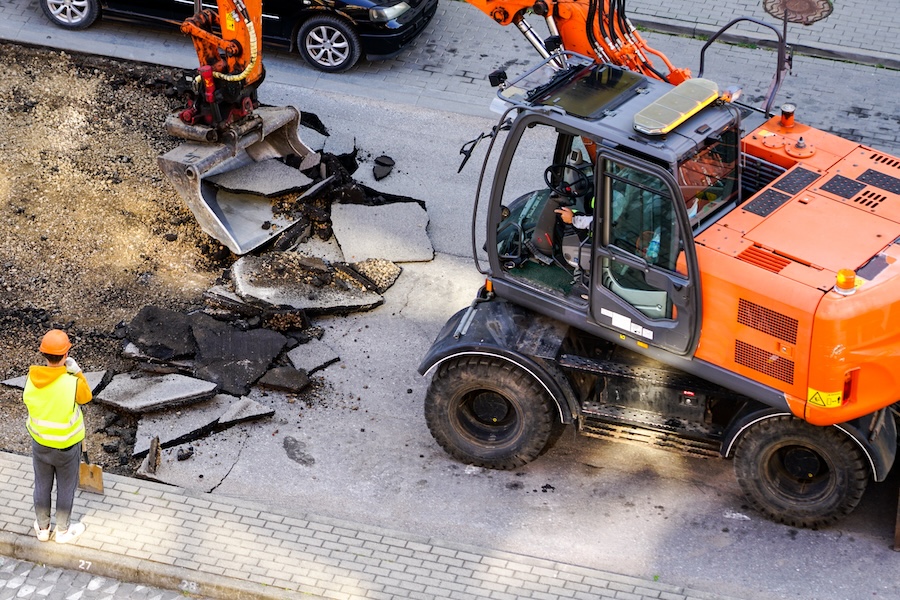
View the complete article here.
Demolition projects demand precision, efficiency, and power. Earthmoving equipment, such as excavators, bulldozers, and loaders, plays a vital role in these operations, enabling contractors to tear down structures safely and clear debris quickly. However, using these machines effectively requires careful planning, proper techniques, and adherence to safety protocols. Here’s a comprehensive guide to using earthmoving equipment for demolition jobs.
Choose the Right Equipment for the Job
Selecting the appropriate earthmoving equipment is critical to ensure efficiency and safety during demolition. Consider the following:
- Excavators: Versatile and powerful, excavators are ideal for breaking down structures, digging trenches, and removing debris. Equipped with attachments like hydraulic breakers, grapples, or shears, they can tackle a wide range of tasks.
- Bulldozers: Perfect for pushing debris, clearing land, and leveling ground, bulldozers are especially useful for post-demolition cleanup and site preparation.
- Skid-steer loaders and compact track loaders: These machines are great for maneuvering in tight spaces and handling lighter demolition work or debris removal.
- Backhoes: With their dual-functionality (digging and loading), backhoes are excellent for small-scale demolition and material handling.
Each project is unique, so evaluate the size and type of structure, access limitations, and debris-handling requirements before selecting your equipment.
Plan the Demolition Process
Demolition is a complex process that requires careful planning to ensure safety and efficiency. Follow these steps to create a solid plan:
- Site assessment: Conduct a thorough inspection of the site and structure to identify potential hazards, such as unstable walls, utility lines, or asbestos-containing materials.
- Permits and compliance: Obtain the necessary permits and ensure compliance with local regulations regarding demolition, waste disposal, and environmental impact.
- Sequence of demolition: Plan the order in which structures will be dismantled to prevent unexpected collapses. Start with non-load-bearing elements before addressing structural supports.
Use the Right Attachments for Efficiency
Earthmoving equipment can be enhanced with specialized attachments for demolition tasks:
- Hydraulic breakers: Use these for breaking through concrete, asphalt, and masonry.
- Demolition shears: Ideal for cutting through metal beams, pipes, and rebar.
- Grapples: These allow operators to grab and move large pieces of debris, reducing the need for manual labor.
- Buckets: Use standard or heavy-duty buckets for scooping and loading materials into trucks or dumpsters.
- Rippers: Rippers are useful for tearing through tough materials, such as asphalt or compacted soil.
Selecting the right attachment for each task increases productivity and reduces wear on your equipment.
Prioritize Safety
Demolition work comes with inherent risks, but these can be mitigated through proper safety measures:
- Training and certification: Ensure all operators are properly trained and certified to handle the equipment and understand demolition-specific hazards.
- Personal protective equipment (PPE): Workers should wear hard hats, steel-toed boots, gloves, eye protection, and high-visibility vests at all times.
- Dust control: Use water sprays or misting systems to minimize dust, which can pose health risks and reduce visibility.
- Exclusion zones: Establish and enforce safety zones around the demolition site to keep unauthorized personnel out of harm’s way.
Regular safety meetings and pre-demolition briefings can help reinforce these protocols.
Optimize Debris Management
Efficient debris management is crucial for keeping the site organized and minimizing downtime.
- Sort materials on-site: Separate recyclable materials (like metal and concrete) from general waste to streamline disposal and recycling efforts.
- Use loaders for cleanup: Skid-steer loaders or wheel loaders can quickly collect and transport debris to designated disposal areas or trucks.
- Plan for hauling: Coordinate with waste management companies to ensure timely removal of debris, avoiding site congestion.
Effective debris management not only improves site safety but also reduces project costs through recycling and proper waste disposal.

Monitor Equipment Maintenance
Earthmoving equipment endures heavy stress during demolition, making regular maintenance essential for safety and efficiency.
- Inspect before use: Check for signs of wear, leaks, or damage in hydraulic lines, tracks, and attachments.
- Lubricate moving parts: Proper lubrication reduces wear and tear, extending the life of your equipment.
- Track usage hours: Follow the manufacturer’s recommended maintenance schedule for servicing components like engines, filters, and fluids.
Ignoring maintenance can lead to costly downtime and increase the risk of accidents.
Adapt to Confined or Challenging Sites
Demolition jobs often involve tight spaces, urban areas, or uneven terrain. Here’s how to navigate these challenges:
- Compact equipment: Use mini-excavators or skid-steer loaders for precise operations in confined spaces.
- Stabilization: In areas with uneven ground, ensure equipment is properly stabilized using outriggers or mats.
- Noise control: In urban environments, limit noise pollution by using quieter equipment and scheduling work during approved hours.
Tailoring your approach to the specific site conditions will minimize disruptions and improve efficiency.
Environmental Considerations
Demolition projects can have environmental impacts, so it’s important to mitigate them:
- Asbestos and hazardous materials: Test for hazardous materials and hire professionals for safe removal and disposal.
- Recycling: Salvage materials like metal, wood, and concrete to reduce landfill waste and lower project costs.
- Erosion control: Protect surrounding areas by implementing erosion-control measures, such as silt fences or barriers.
By integrating sustainability practices, contractors can meet environmental regulations and reduce the ecological footprint of their projects.
View the complete article here.
What type of earthmoving equipment is best for demolition?
Excavators, bulldozers, skid-steer loaders, and backhoes are commonly used, with attachments like hydraulic breakers and grapples enhancing efficiency.
How can demolition sites be kept safe?
Safety can be ensured through proper training, PPE use, dust control, exclusion zones, and regular equipment maintenance.













































